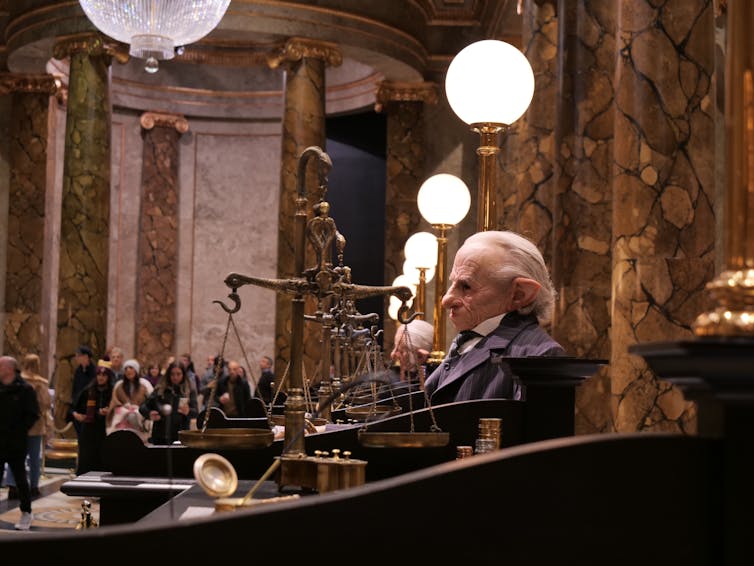In its first two weeks after being released, the video game Hogwarts Legacy, described by the developer as “set in the world of the Harry Potter books,” sold 12 million copies and made about US$850 million in revenue.
Despite its commercial success, the game has been at the centre of heated online debates around the use of antisemitic tropes in its imagery and story line.
The Campaign Against Antisemitism tweeted that the portrayal of goblins in the Harry Potter universe are “the product of centuries of association of Jews with grotesque and malevolent creatures in folklore, as well as money and finance.” These associations have “become so ingrained in the Western mind that their provenance no longer registers with creators or consumers.”
Makers of the game haven’t responded to criticism about antisemitism.
The antisemitic tropes present in Hogwarts Legacy have such deep roots in our shared cultural repertoire that they remain invisible to us, or we remain indifferent to them.
Antisemitic tropes
Hogwarts Legacy maintains the associations built into antisemitic tropes. This normalizes hatred and violence against Jews, which, according to the Anti-Defamation League in the United States, is already at its highest level recorded since 1979. The number of violent antisemitic incidents in Canada rose more than 700 per cent in 2021 compared to 2020.
It is necessary to call out overt antisemitism. It is also important to identify when antisemitism is normalized to the point of becoming habitual. We should be concerned when threads of blame that trace back at least as far as the Middle Ages are visible today.
My research has examined how past patterns of scapegoating persist into the modern day through our (often unknowing) participation.
Scapegoating involves shifting blame onto a group for societal issues and fabricating the need to expel or control the threat. But the target of scapegoating must be credible, meaning that who we choose to blame will draw upon existing fears and prejudices.

(Shutterstock)
Goblins and economic scapegoating
Given that goblins as mythical creatures originate in 14th century European folklore, it is worthwhile to consider how the antisemitic myths of the time may have influenced their construction.
In the 14th century, European life was structured around Christianity, not only as a common religion but as the foundation for social and cultural organization.
In this context, blaming Jews for societal problems, most famously the bubonic plague, was possible because it drew upon centuries of Jewish persecution. Medieval art is rife with antisemitic woodcuts and drawings portraying Jews with particular physical characteristics: short stature, large hooked-noses and hairy features.
Heavy historical baggage
We see these aesthetic features in imagery from the most notorious and widely distributed antisemitic publication of modern times, the Protocols of the Elders of Zion (1903), and throughout Nazi propaganda.
So, while an artist depicting goblins may not intend them to be Jewish, particular combinations of features carry heavy historical baggage.
This archetype has been absorbed and reinforced by art and media since the Middle Ages, and the portrayal of the goblins in Hogwarts Legacy is no exception. Jewish or not, they resemble antisemitic caricatures with histories far longer than the Harry Potter franchise.
A goblin horn?
What the players learn about goblins in the game is partly through the discovery of certain items. Players may come across a “goblin artefact,” which is described as a “horn used by goblins during the 1612 Goblin Rebellion to rally troops and generally annoy witches and wizards.”
While this kind of detail is common in open world games, and helps add realism and depth to the game-play, this particular “artefact” looks remarkably like a shofar, a sacred Jewish musical instrument.

(Shutterstock)
Even worse, 1612 was the year that began the Fettmilch Uprising in present-day Germany, where the Jewish community of Frankfurt am Main was expelled from the city as a result of a pogrom following built-up economic resentment. If there is a defining and lasting stereotype of Jews, it is that they have a disproportionate influence in economic matters.
Feudal roots
It is not surprising, then, that the goblins in Hogwarts Legacy are obsessed with gold, and effectively run the entire wizarding economy. This, combined with their aesthetic features (short, hook-nosed and hairy) and the “goblin artefact,” paints a picture of who is “really” in economic control.
This image has roots back to feudal societies that pushed Jews into financial roles and barred them from doing much else. And this image has influence. Kanye West’s recent comments exemplify how the ongoing associations between Jews and money can escalate into outright Jew hatred.
Reinforce conspiracies
Even if the Hogwarts goblins weren’t created to “look Jewish,”
and even if, as some commentators suggest, the game calls into question the process and practice of “othering” enemies, goblin images reinforce conspiracies that already exist in our collective consciousness — whether we agree with them or not.
Tracing the threads of blame between the past and present can reveal ongoing associations so ingrained as to become almost invisible. However, it is much easier to recognize scapegoating in retrospect than it is to catch ourselves in the act. Public discussions surrounding Hogwarts Legacy offer an entry point to do just that.




